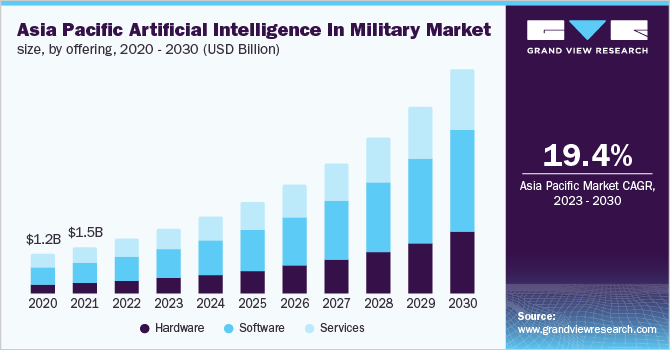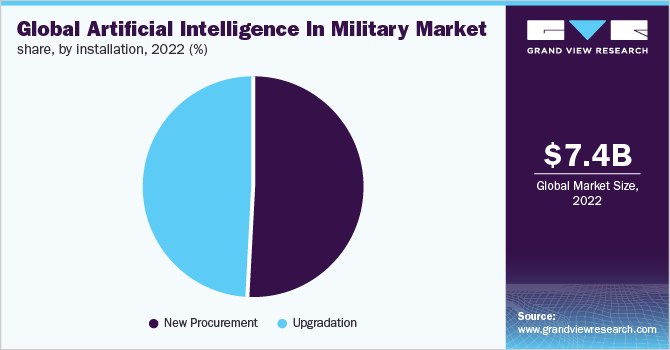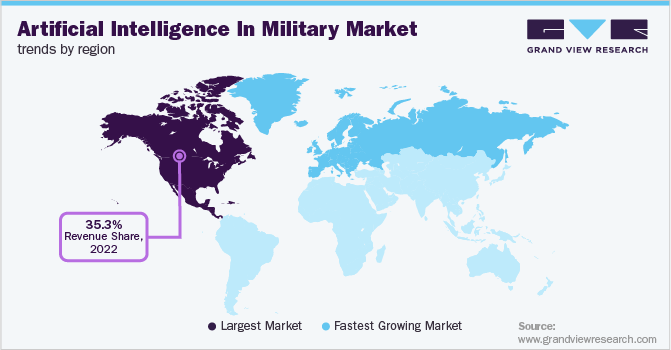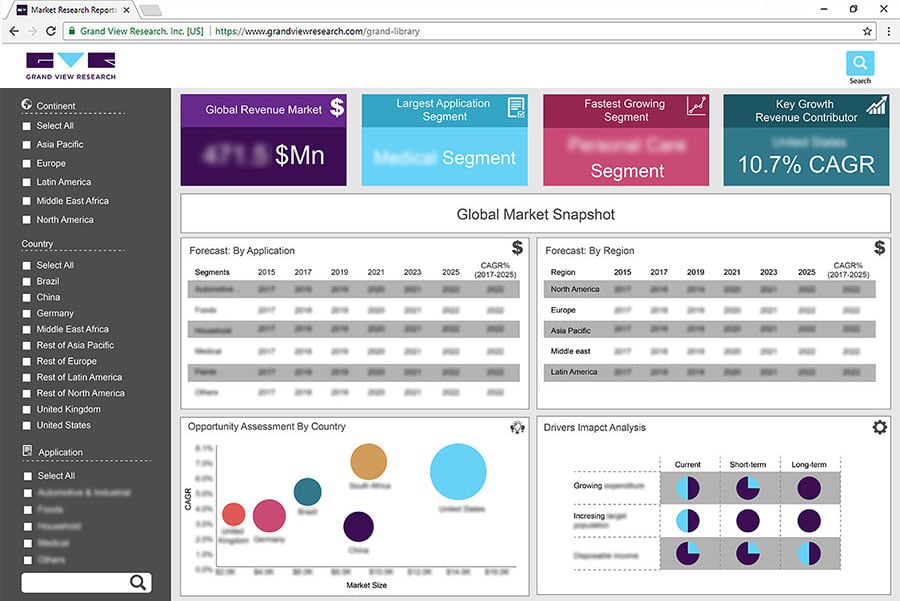- Home
- »
- Next Generation Technologies
- »
-
Artificial Intelligence In Military Market Size Report, 2030GVR Report cover
![Artificial Intelligence In Military Market Size, Share & Trends Report]()
Artificial Intelligence In Military Market Size, Share & Trends Analysis Report By Offering, By Application, By Technology, By Platform, By Installation, By Region, And Segment Forecasts, 2023 - 2030
- Report ID: GVR-4-68040-021-3
- Number of Report Pages: 150
- Format: PDF, Horizon Databook
- Historical Range: 2017 - 2021
- Forecast Period: 2023 - 2030
- Industry: Technology
Report Overview
The global artificial intelligence in military market size was valued at USD 7,448.4 million in 2022 and is expected to expand at a compound annual growth rate (CAGR) of 12.8% from 2023 to 2030. Increased government spending on the R&D of military weaponry with AI capabilities, development of specialized AI chips, growing adoption of big data in the defense industry, growing private investment in the R&D of AI-based military technology, and incidence of animosity and cross-border wars in various countries are some of the main factors anticipated to propel the growth of AI in the military sector. For instance, in June 2022, The Ministry of Defense (MoD) announced the U.K.'s Defense AI Strategy, which stated the safe, ambitious, and responsible use of AI and a set of ethical guidelines designed to govern the military and defense sectors' use of AI.

Training and simulation are broad fields combining system and software engineering principles to build models that can help soldiers train on various fighting systems used in military operations.U.S. Army is investing significant time and resources in virtual reality (VR), augmented reality (AR), and mixed reality (MR) equipment and training to make infantry safer and better prepared. For instance, in October 2022, as part of an operational assessment coordinated by the U.S. Army Test and Evaluation Command, Fort Hood's Combat Tactical Training Center hosted 150 soldiers to prepare them for realistic battlefield training.
The rising use of AI-powered cybersecurity is anticipated to increase the need for artificial intelligence in the military sector during the projected period. In October 2022, the Georgia Institute of Technology granted a $22.7 million contract by the U.S. Defense Advanced Research Projects Agency (DARP) to create strategies for identifying, controlling, and defeating hackers and assisting in the integration of cybersecurity. AI chips have increased, with chipmakers developing various types of these chips to power AI applications like computer vision, natural language processing, network security, and robotics across a wide range of industries, including automotive, IT, retail, and healthcare.
Offering Insights
The software segment held the largest revenue share of 43.1% in 2022. The significance of AI software in creating the IT infrastructure and preventing security breaches is attributed to the segment's expansion. The increasing technological advancement in artificial intelligence creates innovative AI software and related software development tools anticipated to propel AI in the military sector in the coming years. AI software integrated with computer systems executes complex procedures by combining data from hardware systems and processing it in an AI system to produce an intelligent response.
The hardware segment is predicted to register a significantly robust revenue growth throughout the projection period due to the increasing usage of AI technology for complicated processes and increasing demand for specialized hardware components such as AI processors and memory. AI processors are neuromorphic processing units that are significantly faster and more efficient than traditional processors. Memory is an important technology for advancing artificial intelligence processing. AI and machine learning can generate and analyze increasing amounts of mission data in real-time, creating opportunities for autonomous cognitive electronic warfare and leading to the growth of the hardware sector.
Application Insights
The information processing segment held the largest revenue share of 14.9% in 2022. The revenue for the information processing category is anticipated to grow rapidly due to a growing reliance on big data for decision-making. The application of AI at the point of data collection helps the user to analyze a large amount of data and draw appropriate conclusions in a substantially shorter amount of time.
For instance, In December 2020, Northrop Grumman Corporation, an American multinational aerospace and defense technology company, collaborated with Deepwave Digital, a dedicated team of radio frequency industry experts, to promote the development and integration of artificial intelligence (AI) technologies. This partnership will boost communications processing power for next-generation defense capabilities.
The cyber security segment is predicted to grow significantly faster, with a CAGR of 15.5% during the forecast period. The development of new tools and technology has increased the global rate of cybercrime. Similarly, state-sponsored cyberattacks have increased considerably. Corporate and government entities are rapidly embracing AI-based solutions that can efficiently forecast, prevent, and respond to cyber threats.
AI enables deep learning and machine learning to perform predictive analytics; these AI solutions have huge potential for defense sectors and are anticipated to emerge in crucial areas such as decision-support systems, cyber defense, risk management, virus detection, and pattern recognition.
Technology Insights
The machine learning segment is expected to account for the largest revenue share of 26.0% in 2022. Machine learning-enabled military systems are capable of efficiently handling larger volumes of data. Moreover, Machine learning also enhances self-control, self-regulation, and the self-actuation of the combat system.
For instance, in March 2022, Defense Advanced Research Projects Agency (DARPA) officials in Virginia issued a comprehensive agency statement for the in the Moment (ITM) initiative. ITM aims to create AI and machine learning algorithms based on human traits.
Revenue from the Computer vision segment in the AI in the military industry is expected to grow during the forecast period. Computer vision programs are being developed to filter through a large amount of data and alert military intelligence officers to the presence of strategically important items or individuals.
Moreover, autonomous weapon platforms use computer vision technology to recognize and track objects, and AI can assist in extracting meaningful information from equipment such as radars and automated identification systems. Thus, improving military tools, weapons, and equipment with advanced technology drives the expansion of artificial intelligence in the military sector.
Platform Insights
The space segment held the largest revenue share of 33.4% in 2022. The space segment includes satellite data processing, intelligent navigation systems, and AI assistant robots for space exploration. Integrating space segments with an AI platform enables effective ground station and spacecraft communication. Space AI incorporates satellite sub-systems that form the foundation of other communication systems. The defense industry uses space-based sensors, artificial intelligence, and a scalable ground system that can connect to the army's weapon systems and offer better target recognition and sensing capabilities.
The land accounts for 29.1% revenue share in 2022. The land segment includes autonomous combat vehicles, unmanned ground vehicles, and autonomous combat robots. The rise in demand for unmanned ground vehicles to perform civilian tasks and lower dangers to human lives drive the expansion of the land segment in the AI in the military industry during the projected period.
The combination of combat vehicles and autonomy is essential for avoiding casualties in war scenarios. For instance, in November 2019, General Dynamics Land Systems, a U.S.-based military vehicle manufacturer, introduced MUTT (Multi-Utility Tactical Support) UGV. The vehicle offers intelligence, surveillance, target acquisition, and reconnaissance (ISTAR) to dismounted infantry troops in any environment.
Installation Insights
The new procurement segment accounted for the largest revenue share of 50.6% in 2022. This is attributed to the government's increased drive to include AI in the defense sector and the rise of new developments related to AI technology in the military industry. For instance, in December 2021, The National Security Council Secretariat, an Indian organization that manages critical political, economic, energy, and security problems, supported the Army in creating the Quantum Lab at the Military College of Telecommunication Engineering in India to enhance artificial intelligence research and training.

Incorporating AI into regular military operations could upgrade logistics, administration, maintenance, training, personal management, and routine activities or exercises, which is responsible for propelling the growth of the upgradation sector in AI in the military market during the forecasted period. Moreover, it can reduce institutional workload and free up warriors for core operations. The upgradation of AI in defense is transforming warfare from customized mechanized conflict to intelligent robotized digitized dispute. Moreover, Global powers are preparing their military forces to use modern intelligent technologies to optimize war consequences.
Regional Insights
North America registered the largest revenue share of 35.3% in 2022, due to the increasing investment in artificial intelligence technologies by the major countries in North America. The U.S. dominates this sector and is investing in AI. systems to preserve its military dominance and reduce the risk of possible network threats.
For instance, In November 2020, C3.ai, Inc., an enterprise A.I. software provider, announced a collaboration with Raytheon Intelligence & Space, a producer of advanced sensors, training, software, and hardware. This collaboration aimed to create artificial intelligence programs for aerospace and defense operations for government clients, such as the U.S. Air Force and the intelligence community.

Market revenue in Europe is anticipated to grow significantly throughout the forecast period due to Russia's modernization of its weapons. The Russian government invested considerable money in creating information management technologies to improve decision-making in actual combat circumstances.
For instance, in August 2022, The Russian Ministry of Defense introduced a department dedicated to developing artificial intelligence weapons. A new department is created to accelerate work on the application of artificial intelligence technology to produce models of firearms for military and special equipment.
Key Companies & Market Share Insights
The market is characterized by strong competition, with a few major worldwide competitors owning a significant market share. The major focus is on developing new products and collaboration among the key players due to the changing requirements of the armed forces worldwide.
For instance, in November 2022, BAE Systems plc, a London-based multinational arms, security, and aerospace company, collaborated with Inzpire, a supplier of defense-managed services. Through this partnership, the collective training experts at Inzpire will collaborate with BAE Systems to develop a single synthetic environment that will allow armed units to train safely using real-world mission software and tactics, providing high-fidelity, immersive training. Some prominent players in the global artificial intelligence in military market include:
-
BAE Systems Plc.
-
Charles River Analytics, Inc.
-
International Business Machines Corporation
-
L3Harris Technologies Inc.
-
Lockheed Martin Corporation
-
Northrop Grumman Corporation
-
Rafael Advanced Defense Systems
-
Raytheon Technologies Corporation
-
SparkCognition
-
Thales Group
Artificial Intelligence in Military Market Report Scope
Report Attribute
Details
Market size value in 2023
USD 8,315.4 million
Revenue forecast in 2030
USD 19,292.7 million
Growth rate
CAGR of 12.8% from 2023 to 2030
Base year for estimation
2022
Historical data
2017 - 2021
Forecast period
2023 - 2030
Quantitative units
Market revenue in USD million & CAGR from 2023 to 2030
Report coverage
Revenue forecast, company ranking, competitive landscape, growth factors, and trends
Segments covered
Offering, application, technology, platform, installation, region
Regional scope
North America; Europe; Asia Pacific; South America; MEA
Country scope
U.S.; Canada; Mexico; U.K.; Germany; China; India; Japan; Brazil
Key companies profiled
Lockheed Martin Corporation; BAE Systems, Inc.; Northrop Grumman Corporation; Raytheon Technologies;Rafael Advanced Defense Systems; SparkCognition; L3Harris Technologies Inc.;International Business Machines Corporation; Thales Group
Customization scope
Free report customization (equivalent up to 8 analysts working days) with purchase. Addition or alteration to country, regional, and segment scope.
Pricing and purchase options
Avail customized purchase options to meet your exact research needs. Explore purchase options
Global Artificial Intelligence In Military Market Segmentation
This report forecasts revenue growth on global, regional, and country levels and provides an analysis of the latest industry trends in each of the sub-segments from 2017 to 2030. For this study, Grand View Research has segmented the global artificial intelligence in military market report based on offering, application, technology, platform, installation, and region:
-
Offering Outlook (Revenue, USD Million, 2017 - 2030)
-
Hardware
-
Software
-
Services
-
-
Application Outlook (Revenue, USD Million, 2017 - 2030)
-
Warfare Platform
-
Cyber Security
-
Logistics & Transportation
-
Surveillance & Situational Awareness
-
Command & Control
-
Battlefield Healthcare
-
Simulation & Training
-
Information Processing
-
Threat Detection
-
Others
-
-
Technology Outlook (Revenue, USD Million, 2017 - 2030)
-
Machine Learning
-
Deep Learning
-
Natural Language Processing
-
Context-Aware Computing
-
Computer Vision
-
Intelligent Virtual Agent (Iva) /Virtual Agents
-
Others
-
-
Platform Outlook (Revenue, USD Million, 2017 - 2030)
-
Land
-
Naval
-
Airborne
-
Space
-
-
Installation Outlook (Revenue, USD Million, 2017 - 2030)
-
New Procurement
-
Upgradation
-
-
Regional Outlook (Revenue, USD Million, 2017 - 2030)
-
North America
-
U.S.
-
Canada
-
Mexico
-
-
Europe
-
U.K.
-
Germany
-
France
-
-
Asia Pacific
-
China
-
Japan
-
India
-
-
South America
-
Brazil
-
-
Middle East and Africa
-
Frequently Asked Questions About This Report
b. The global artificial intelligence in military market size was estimated at USD 7,448.4 million in 2022 and is expected to reach USD 8,315.4 million in 2022.
b. The global artificial intelligence in military market is expected to grow at a compound annual growth rate of 12.8% from 2022 to 2030 to reach USD 19,292.7 million by 2030.
b. North America dominated the artificial intelligence in military market with a share of 35.3% in 2022.The growing defence spending in North America to improve AI capabilities is attributed to the growth of AI in the military market.
b. Some key players operating in the AI in military market include BAE Systems Plc., Charles River Analytics, Inc., International Business Machines Corporation, L3Harris Technologies Inc., Lockheed Martin Corporation, Northrop Grumman Corporation, Rafael Advanced Defense Systems, Raytheon Technologies Corporation, SparkCognition, Thales Group
b. Key factors that are driving the market growth include increased governmental expenditure in the defense industry to augment growth, and the growing demand for advanced military equipment is attributed to the growth of artificial intelligence in the military market.
Share this report with your colleague or friend.
![gvr icn]()
NEED A CUSTOM REPORT?
We can customize every report - free of charge - including purchasing stand-alone sections or country-level reports, as well as offer affordable discounts for start-ups & universities. Contact us now
![Certified Icon]()
We are GDPR and CCPA compliant! Your transaction & personal information is safe and secure. For more details, please read our privacy policy.
We are committed towards customer satisfaction, and quality service.
"The quality of research they have done for us has been excellent."





